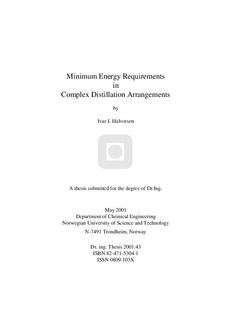| dc.description.abstract | Distillation is the most widely used industrial separation technology and distillation units are responsible for a significant part of the total heat consumption in the world’s process industry. In this work we focus on directly (fully thermally) coupled column arrangements for separation of multicomponent mixtures. These systems are also denoted Petlyuk arrangements, where a particular implementation is the dividing wall column. Energy savings in the range of 20-40% have been reported with ternary feed mixtures. In addition to energy savings, such integrated units have also a potential for reduced capital cost, making them extra attractive. However, the industrial use has been limited, and difficulties in design and control have been reported as the main reasons. Minimum energy results have only been available for ternary feed mixtures and sharp product splits. This motivates further research in this area, and this thesis will hopefully give some contributions to better understanding of complex column systems.
In the first part we derive the general analytic solution for minimum energy consumption in directly coupled columns for a multicomponent feed and any number of products. To our knowledge, this is a new contribution in the field. The basic assumptions are constant relative volatility, constant pressure and constant molar flows and the derivation is based on Underwood’s classical methods. An important conclusion is that the minimum energy consumption in a complex directly integrated multi-product arrangement is the same as for the most difficult split between any pair of the specified products when we consider the performance of a conventional two-product column. We also present the Vmin-diagram, which is a simple graphical tool for visualisation of minimum energy related to feed distribution. The Vmind-diagram provides a simple mean to assess the detailed flow requirements for all parts of a complex directly coupled arrangement.
The main purpose in the first part of the thesis has been to present a complete theory of minimum energy in directly coupled columns, not a design procedure for engineering purposes. Thus, our focus has been on the basic theory and on verification and analysis of the new results. However, based on these results, it is straightforward to develop design procedures including rigorous computations for real feed mixtures without the idealized assumptions used to deduce the analytic results.
In part 2 we focus on optimization of operation, and in particular the concept of self-optimizing control. We consider a process where we have more degrees of freedom than are consumed by the product specifications. The remaining unconstrained degrees of freedom are used to optimize the operation, given by some scalar cost criterion. In addition there will in practice always be unknown disturbances, model uncertainty and uncertainty in measurements and implementation of manipulated inputs, which makes it impossible to precalculate and implement the optimal control inputs accurately.
The main idea is to achieve self-optimizing control by turning the optimization problem into a constant setpoint problem. The issue is then to find (if possible) a set of variables, which when kept at their setpoints, indirectly ensures optimal operation.
We have used the ternary Petlyuk arrangement to illustrate the concept. It is a quite challenging case where the potential energy savings may easily be lost if we do not manage to keep the manipulated inputs at their optimal values, and the optimum is strongly affected by changes in feed composition and column performance. This also applies to the best control structure selection, and we believe that the reported difficulties in control are really a control structure problem (the task of selecting the best variables to control and the best variables to manipulate).
In this analysis we present in detail the properties of the Petlyuk arrangement, and show how important characteristics depend on the feed properties and product purity. We have used finite stage-by-stage models, and we also show how to use Underwood’s equations to compute the energy consumption for infinite number of stages for any values of the degrees of freedom. Such computations are very simple. The results are accurate and in terms of computation time, outperform simulations with finite stage-by-stage models by several magnitudes. The analysis gives a basic understanding of the column behaviour and we may select operating strategies based on this knowledge for any given separation case. In some cases there will be a quite flat optimality region, and this suggests that one of the manipulated inputs may be kept constant.We also show that the side-stream purity has strong impact on the optimality region. One observation is that a symptom of sub-optimal operation can be that we are unable to achieve high sidestream purity, and not necessarily increased energy consumption.
In summary, the presented results contribute to improved understanding and removal of some uncertainties in the design and operation of directly integrated distillation arrangements. | nb_NO |
